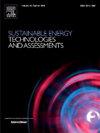Establishing an implementation framework for dynamic carbon monitoring in the AEC industry
IF 7.1
2区 工程技术
Q1 ENERGY & FUELS
Sustainable Energy Technologies and Assessments
Pub Date : 2025-04-01
DOI:10.1016/j.seta.2025.104289
引用次数: 0
Abstract
Real-time carbon emission monitoring could provide high-quality data to inform carbon reduction strategies. Nevertheless, the architecture, engineering, and construction (AEC) industry currently relies on static, pre- or post-assessments of carbon emissions, leading to a gap between estimated and actual emissions, which hinders timely intervention to reduce emissions. Consequently, securing accurate and up-to-date data on actual carbon emissions emerges as a critical imperative. This study systematically reviews recent research on real-time carbon monitoring in the AEC industry from 2010 to 2024, focusing on key aspects such as monitoring object, boundary, dynamic data acquisition method, carbon calculation method, and functional services. The research findings indicate that GPS, BIM, RFID, and Sensors are the primary technologies employed for real-time carbon monitoring, with Sensor technology uniquely suited for the full life cycle monitoring. However, their integration remains limited, hindering fully automated real-time monitoring. Current monitoring systems primarily focus on carbon monitoring, neglecting potential for carbon prediction and early warning functionalities. These systems offer homogeneous functions with limited integration. Furthermore, the study proposes a framework for developing comprehensive carbon monitoring systems in AEC industry from five aspects. This study offers tailored methodological guidance for practitioners and valuable insights for researchers exploring carbon monitoring’s future trajectory.
建立AEC行业动态碳监测实施框架
实时碳排放监测可以为碳减排战略提供高质量的数据。然而,目前建筑、工程和施工(AEC)行业依赖于静态的、预评估或后评估的碳排放,导致估算排放量与实际排放量之间存在差距,阻碍了及时干预减排。因此,确保准确和最新的实际碳排放数据成为当务之急。本文系统回顾了2010 - 2024年AEC行业实时碳监测研究进展,重点从监测对象、监测边界、动态数据采集方法、碳计算方法、功能服务等方面进行分析。研究结果表明,GPS、BIM、RFID和传感器是实时碳监测的主要技术,传感器技术非常适合全生命周期监测。然而,它们的集成仍然有限,阻碍了完全自动化的实时监控。目前的监测系统主要侧重于碳监测,忽视了碳预测和早期预警功能的潜力。这些系统提供同质的功能,但集成有限。在此基础上,从五个方面提出了AEC行业碳综合监测体系的构建框架。本研究为从业者提供了量身定制的方法指导,并为探索碳监测未来轨迹的研究人员提供了宝贵的见解。
本文章由计算机程序翻译,如有差异,请以英文原文为准。
求助全文
约1分钟内获得全文
求助全文
来源期刊

Sustainable Energy Technologies and Assessments
Energy-Renewable Energy, Sustainability and the Environment
CiteScore
12.70
自引率
12.50%
发文量
1091
期刊介绍:
Encouraging a transition to a sustainable energy future is imperative for our world. Technologies that enable this shift in various sectors like transportation, heating, and power systems are of utmost importance. Sustainable Energy Technologies and Assessments welcomes papers focusing on a range of aspects and levels of technological advancements in energy generation and utilization. The aim is to reduce the negative environmental impact associated with energy production and consumption, spanning from laboratory experiments to real-world applications in the commercial sector.
 求助内容:
求助内容: 应助结果提醒方式:
应助结果提醒方式:


